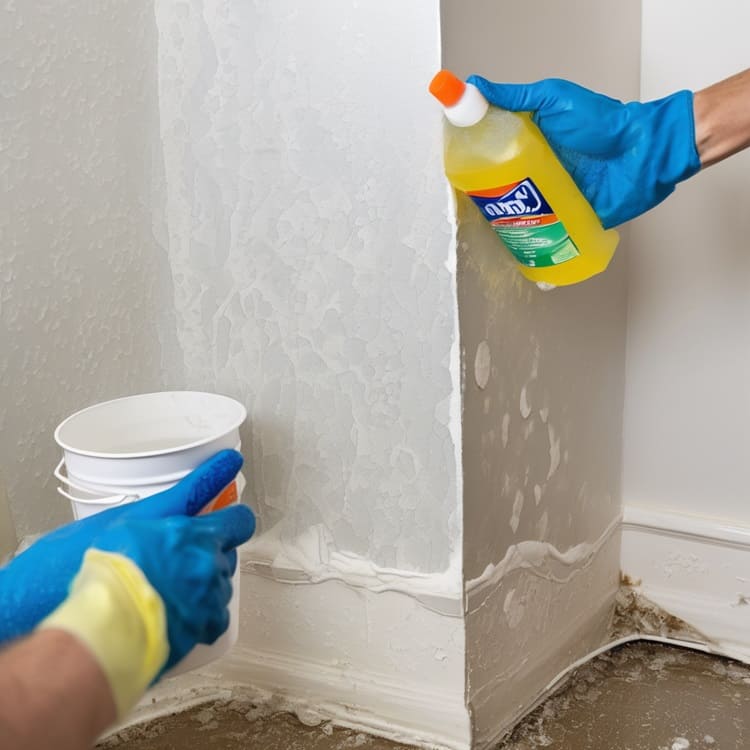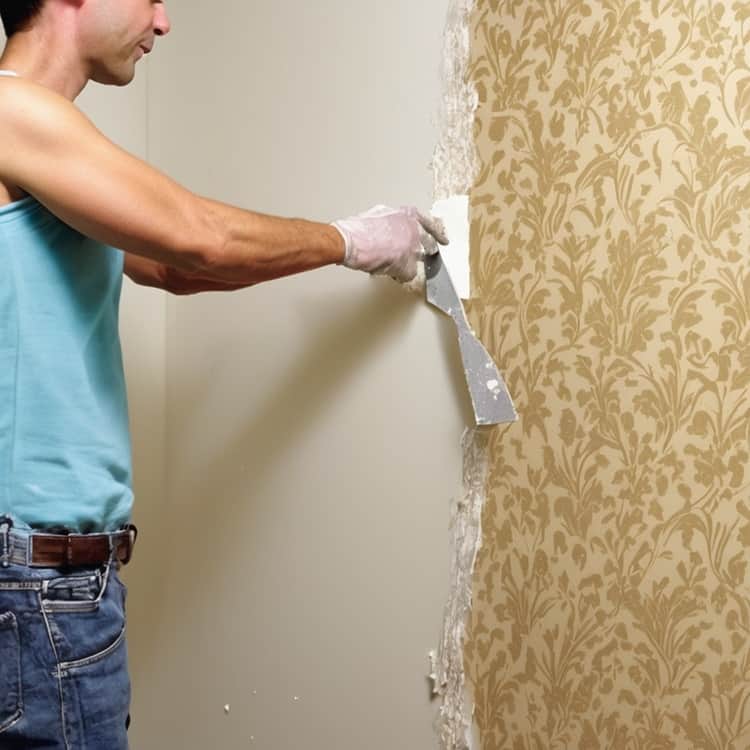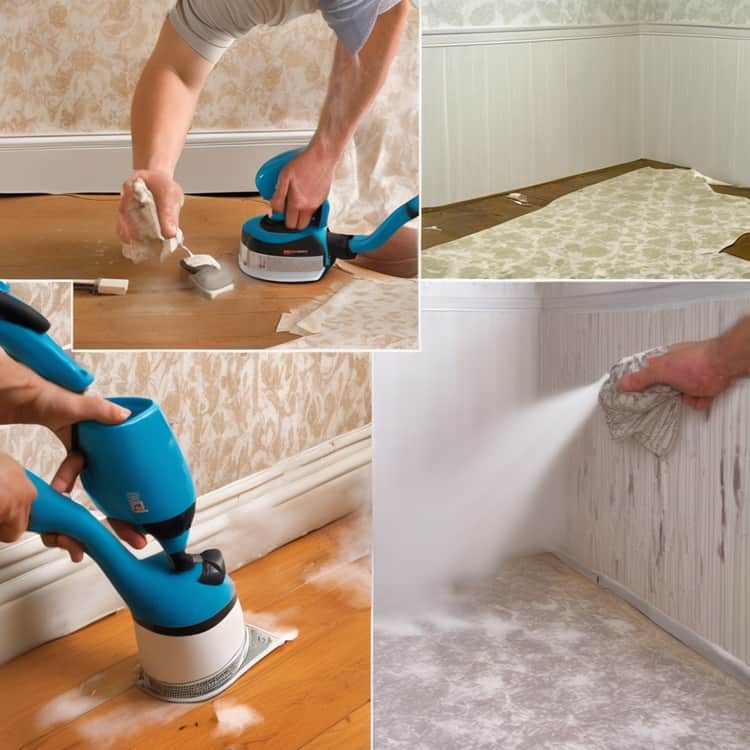Wallpaper can be a beautiful and stylish addition to any room, but it can also be a pain to remove when ready for a change. I’ll discuss some of the best easy ways on how to remove wallpaper from drywall, including using a wallpaper steamer, chemical strippers, and a scoring tool.
If you’re planning to remove wallpaper from drywall, there are a few different methods you can use, depending on the type of wallpaper and the condition of the drywall.
I’ll also provide tips on how to avoid damaging the drywall during the removal process.
The easiest way to remove wallpaper from drywall is to use a wallpaper steamer. The steam penetrates the adhesive, making peeling the wallpaper easier without damaging the drywall.
If you don’t have a wallpaper steamer, use chemical strippers or a scoring tool.
However, chemical strippers can be harsh and should be used cautiously, and a scoring tool will only work on thin wallpaper with weak adhesive.
Read More How To Clean Flat Walls Without Removing Paint
Easy Ways How to Remove Wallpaper from Drywall: Tips and Techniques

1. Steam Removal Method
Materials:
- Wallpaper steamer or spray bottle with hot water
- Scoring tool (e.g., wallpaper scorer, utility knife)
- Putty knife
- Sponge or cloth
- Wallpaper paste remover (optional)
- Vinegar (optional)
Instructions:
i. Safety First:
- Wear gloves and eye protection.
- Ensure the room is well-ventilated.
ii. Prepare the Wallpaper:
- Scoring: Use a scoring tool to create small holes in the wallpaper, allowing the steam or water to penetrate.
- Steaming or Spraying: Fill a wallpaper steamer with water and heat it. Alternatively, fill a spray bottle with hot water. Spray or steam the wallpaper evenly, working in sections.
iii. Remove the Wallpaper:
- Use a Putty Knife: Once the wallpaper is saturated, use a putty knife to scrape it off the drywall gently. Start from the top and work your way down.
- Remove Small Pieces: For small pieces that are difficult to remove, use a sponge or cloth to wipe them away.
iv. Clean the Drywall:
- Sponge with Water: Wipe the drywall with a sponge or cloth dampened with clean water to remove any remaining glue.
- Use Wallpaper Paste Remover: If there is stubborn glue residue, apply wallpaper paste remover according to the manufacturer’s instructions.
- Rinse with Vinegar: Dilute vinegar in water (1:1 ratio) and wipe down the drywall to neutralize any remaining chemicals.
v.Dry the Drywall:
- Open windows or use a fan to circulate air and dry the drywall thoroughly.
Tip: Be patient and avoid rushing the process to prevent wall damage.
Note: For plaster walls, avoid leaving the steamer on longer than 30 seconds to prevent cracking.
2. Water & Vinegar Method
This method is budget-friendly and effective:
-
- Mix 4-parts of hot water with 1-part white vinegar in a large bucket.
- Soak a paint roller in the mixture and apply it to a wallpaper section.
- Let it sit for a few minutes, then gently peel off the wallpaper using a putty knife.
3. Liquid Stripper Method
If you prefer a commercial solution, try the liquid stripper method:
-
- Use a wallpaper stripper in a spray bottle.
- Score the wallpaper with a wallpaper scoring tool.
- Spray the stripper onto the wallpaper.
- Wait a few minutes, then scrape off the paper with a putty knife.
4. Commercial Adhesive Remover: Chemical Strippers
Wallpaper chemical strippers can dissolve the adhesive holding the wallpaper to the drywall. However, these products can be harsh and should be used with caution.
5. Heat Gun or Hair Dryer
A heat gun or hair dryer can soften the adhesive, making it easier to remove the wallpaper. However, using the heat gun carefully is important to avoid damaging the drywall.
6. Hot Water and Sponge Method
- Mix hot water with a few drops of dish soap.
- Soak a sponge in the soapy water and gently scrub the adhesive residue.
- Rinse the sponge frequently and wipe away the residue.
- Dry the wall thoroughly afterward.
7. Rubbing Alcohol
- Apply a small amount of rubbing alcohol to a cloth.
- Gently rub the adhesive residue.
- The alcohol will dissolve the sticky residue.
- Wipe clean with a damp cloth.
Essential Tips for Successful Wallpaper Removal

- Protect Your Floors and Baseboards: Lay down sheet plastic or old towels to catch any debris or water.
- Score the Wallpaper: Use a wallpaper scoring tool to create small perforations, allowing the removal solution to penetrate.
- Work in Small Sections: Tackle one area at a time to avoid overwhelming yourself.
- Be Patient: Wallpaper removal takes time, especially if it’s stubbornly clinging to the drywall.
- Test a small area first: Try your chosen removal method on an inconspicuous spot before diving in to see how the wallpaper reacts
- tart from the Edges: Remove the wallpaper from the room’s edges, where it is typically less adhered to the drywall.
- Work in Downward Strokes: When using a putty knife to remove the wallpaper, work in downward strokes to avoid tearing the drywall.
- Use a Wide Putty Knife: A wide putty knife provides more leverage and makes removal more efficient.
- Don’t Force It: If the wallpaper is not coming off easily, don’t force it. Re-steam or respray the area and try again.
- Be Careful with Electrical Outlets and Switches: When removing wallpaper near electrical outlets or switches, turn off the power and cover them with painter’s tape to prevent water damage.
Conclusion: Easy Ways How to Remove Wallpaper from Drywall
Whether you’re a DIY enthusiast or a professional contractor, removing wallpaper from drywall doesn’t have to be a daunting task.
Following the steps outlined in this article, you can remove wallpaper quickly and easily, leaving your drywall in pristine condition.
Remember, whether you choose steam, water vinegar, or a liquid stripper, the key is persistence.

